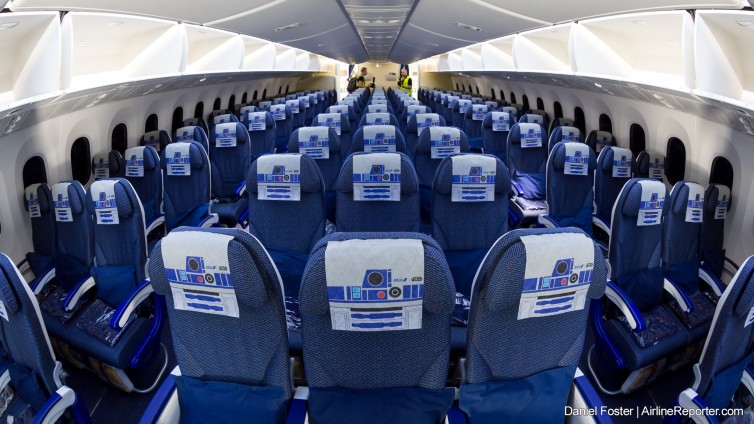
Just some of the adventures we had in 2015… good times
Another year has passed, which means it is time to do a re-cap. With any year-end review, it is great to remember what we have accomplished and see how we have grown and changed since we started in 2008.
We are once again humbled to have the opportunity to experience the things we do. It has taken lots of hard work, and we are always excited to be able to share them with you!
Our team has now grown to over 30 writers, located in 18 cities, on four continents. We have been keeping busy, flying over 600,000 miles this year, making our grand total over 1.4 million miles. We are just short of 75,000 Twitter followers, our Flickr views have passed 7.6 million, and YouTube is now over 2.3 million views. Readership is at a all-time high and we just love that you seem to (mostly) like what we do!

A United 787-9 touching down ’“ Photo: Bernie Leighton | AirlineReporter
United’s daily service from Los Angeles (LAX) to Melbourne (MEL), Australia is the world’s longest Boeing 787 Dreamliner flight. The long flight (UA98 is scheduled for 15 hours, 50 minutes) allowed me to not only put the 787-9 to the test, but also United’s Economy Plus product.
Flights from LAX to Melbourne take off in the late evening and arrive in the early morning, so the outbound flight is quite easy to sleep on, assuming you aren’t contemplating the remoteness of the vast Pacific Ocean. The routing typically takes the aircraft out on runway 25R, and after an eternity over open water, high above Kiribati, American Samoa, and Fiji, before crossing the Tasman Sea, leaving less than an hour of flying time over land.

Economy Plus on the United 787
As you enjoy your breakfast, you can gaze out on a sunrise over the Australian Alps and observe the Dreamliner’s wings, which are nearly free of fuel, in their most upward-bent shape. I was excited for the flight, but not sure if United could come through during such a long trip.

Clayton Scott Field in Renton, WA
As an airport manager, and on behalf of airport management all over the country, I wanted to take a moment and say thank you! If you have flown commercially recently, then this message of gratitude is specifically for you.
Why?
Well, because you are directly contributing to the financial well-being of the airport. And no, I am not talking about supporting the airlines, who in turn pay the airport to offer their services. And I am not referring to your purchase of concessions in the terminal before your flight, or the fee you paid to park, or for gazing at the advertising that companies pay the airport top dollar for.
Rather, I am talking about a nominal fee that is applied to your ticket that goes directly into the airport’s coffers. This fee is the “Passenger Facility Charge” or PFC, and it’s a huge lever in commercial airport infrastructure investment.
It is also a white-hot topic nationally for airports and airlines, as the Federal Aviation Administration (FAA) approaches the end of its temporary authorization in March of 2016.
Last August, AirlineReporter brought exclusive coverage of TWA Wings of Pride’s arrival to Kansas City. Today we bring you another first. A time-lapse of N948TW being transformed from the standard American Airlines bare metal scheme back to its more popular and beloved livery: the inverted TWA double stripe.
Why inverted? Because when TWA received the plane – as a gift from its employees – they wanted a livery that said to the employees and public alike: TWA was reinventing itself from the inside out.

ANA returns to Sydney with the Star Wars 787-9
All Nippon Airways (ANA) has returned to Sydney after a 16-year hiatus, operating their Boeing 787-9 Dreamliners from Tokyo’s Haneda Airport. A stand-out from any other inaugural flight, the ANA Star Wars jet made its debut appearance in Australia’s largest city to celebrate this special event, as well as the upcoming film. As an avid Star Wars fan, I was compelled to be present for the arrival of this work of art.
As exciting as the prospect of ANA returning to Sydney was, the highlight for me was the aircraft tour shortly after arrival.

The R2-D2-style seat covers are a cute addition to the aircraft
After a period of rushing around issuing visitor passes to the media crews, the bus had us out at the runway 15 minutes prior to the arrival of the Star Wars Dreamliner. I was also made aware that people had flocked to the airport to witness this spectacle, with all the usual aircraft spotting areas full. Spotting at Sydney Airport can be a challenge to even the most experienced AvGeek, with runway selections seeming arbitrary at times. Fortunately on this occasion, the plane landed on the runway we hoped for.





